Gas heating convectors: guidelines for choosing the best variety and brand
The heating system at home can be either centralized or autonomous. One of the types of local heaters is a gas heating convector. By purpose, functions and some technical characteristics, it resembles electrical analogues, but it works from another source of energy - liquefied or natural gas.
To find out if heating equipment is suitable for a particular room, you need to get acquainted with its capabilities. We offer useful materials about gas convectors for heating a house and recommendations for choosing household appliances.
The content of the article:
What does a gas convector consist of and how
The gas-fired convector is a complete mini heating system. If you need to heat one room, for example, a large hall in a country house, it is enough to install the device and connect it to a power source - a natural gas pipeline or cylinders. The boiler, pipes, pump, radiators will not need to be purchased separately.
The basis of the principle of operation is a change in the characteristics of the fuel with increasing temperature. The air flow passes through the heat exchanger, heats up and moves up, under the ceiling. It is replaced by colder portions of air that follow the same path. This process is called convection, and the units themselves are called convectors.
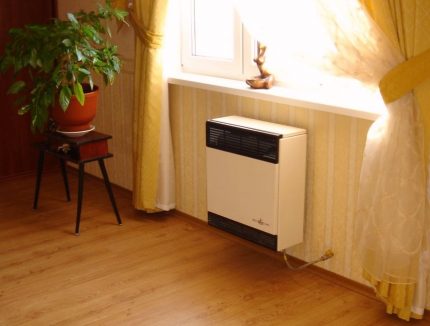
The traditional and technically justified installation site is considered to be the wall section under the window: heat losses in this zone are recognized as maximum.
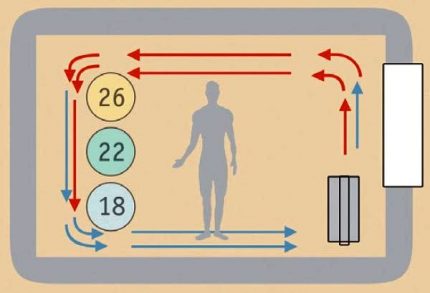
The design of a gas convector is a combination of the following components:
- Housing or casingperforming two functions: protective and decorative. This is a metal box covered with heat-resistant anti-corrosion paint, with holes for air circulation and fittings for installation.
- Gas-burner - element responsible for the combustion of gas. It is coupled with a heat exchanger and equipped with an igniter with an electrode, with the help of which the ignition is performed.
- Heat exchanger performs the main function - heats the air. The larger the surface area, the more efficient the heating will occur, therefore, the ribbed configuration is common.
- Flue system. The combustion products of gas heat generating units are removed in two ways: naturally or forcibly, using the built-in fan. In the first case, combustion is supported by the intake of air from the room, in the second - from the street, through a coaxial pipe.
- Valve, allowing you to adjust the pressure of the fuel entering the combustion chamber. It is connected with a temperature regulator and responds to its signals.
- Thermostat. The combined valve is controlled by a thermostat, which can be set to a comfortable temperature.
- Control system in modern models it is automated. In the event of an emergency: pressure reduction, deficiency of combustion air, fan breakdown, flame attenuation - the convector stops its work.
Heaters with a tangential fan increase the speed of the heated air and warm up the room faster.
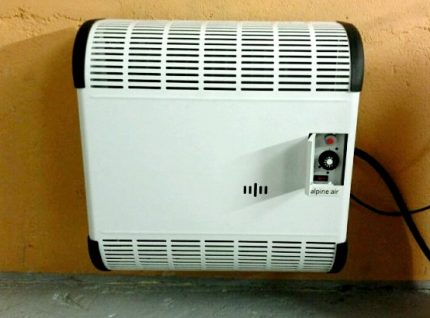
All gas models are universal in relation to the type of fuel. They can operate on both natural and bottled gas. The requirements for combustible materials are set out in GOST 5542-2014.
Pros and cons of gas convection heating
The production of heating appliances is developing due to the demand for gas equipment.
Among the main advantages noted by users are the following:
- Economic benefit. Buying and installing a gas unit is more expensive than an electrical analogue, but subsequently you will have to pay much less for fuel consumption. Especially if the source is natural gas.
- Versatility. Gas appliances are designed to connect both natural and bottled gas. The ability to work on propane will be useful to owners whose homes do not have main fuel.
- Lack of coolant. There is no need to equip the pipeline, and in winter, during the period of inactivity, there is no risk of liquid freezing. Local convection heating is convenient for garages and small cottages.
- Environmental friendliness. Devices with coaxial pipe and a closed combustion chamber does not burn oxygen from residential premises.
But there are some disadvantages. For example, not everyone likes the dimensions of heating appliances - on sale you can find more compact electrical analogues. For residential premises, it is preferable to buy wall models that take up less usable space.
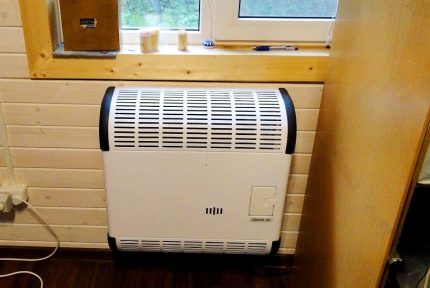
The steel heat exchanger, characteristic of low-cost models, cools quickly, thereby reducing heating efficiency.
Criteria for choosing a heater
Before buying a gas convector on natural or bottled gas it is necessary to analyze the installation conditions, discuss with the installation details the experts and select the device that best meets specific requirements.
Important criteria may include both technical specifications and design or cost. Consider what you need to pay attention to when choosing.
Criterion # 1 - type of combustion chamber
Convectors are equipped with two types of combustion chambers:
- open;
- closed.
According to the method of air intake, the first type resembles a furnace: oxygen to support combustion enters the furnace from the room, and exhaust gases are led out through the pipe. Often, such devices are mounted in place of furnaces, and a pipe for the removal of combustion products is inserted into an existing chimney.
The main disadvantage of the device is the burning of oxygen in the house. Well debugged ventilationconstantly replenishing fresh air. The advantage is low cost.
A closed combustion chamber is considered more acceptable from an environmental point of view.
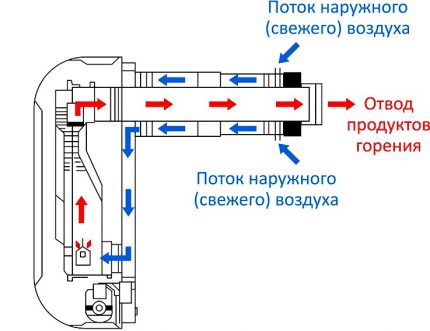
The advantage of devices with a closed combustion chamber is safety, the disadvantage is the need for power supply for the fan to work.
Criterion # 2 - a kind of chimney
Exhaust fumes are vented out through the chimney. All flue pipe assembly options are divided into two categories:
- vertical
- horizontal.
Vertical, typical for open-type appliances, are practically not used in residential premises. Although they have a protection system: auto shutdown when blowing out the burner, lack of oxygen or pressure drop - they are considered unsafe. Mostly they are used for heating industrial premises, garages, cabins.
Coaxial chimneys located horizontally and brought out through a through hole in the wall are applied to devices with a closed-type combustion chamber.
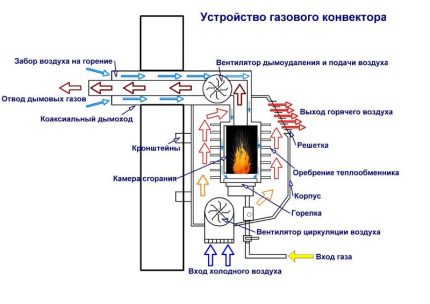
The coaxial chimney pipe has a telescopic structure, so the wall thickness does not matter. On the outside, a protective cap is installed at the end of the pipe to protect it from debris.
Criterion # 3 - floor or wall installation
By the method of installation, all convectors are divided into:
- floor;
- wall mounted.
Floor-standing differ in greater power and heat dissipation, therefore they are installed in spacious rooms - workshops, garages, warehouses. In order for heavy aggregates to remain stable, a solid and even base is prepared before installation.
Wall-mounted appliances are household convectors suitable for living rooms, halls, halls. They occupy a minimum of space, as they are mounted directly to the wall through which the chimney is also led out.
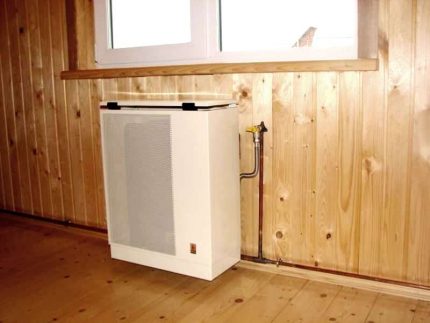
To reduce the load on the wall, the heat exchanger in modern budget models is made of steel, not cast iron.
The cost of floor and wall gas convectors is almost the same, to a greater extent it depends not on the type at the installation site, but on the technical characteristics and materials from which the main parts are made.
Criterion # 4 - fuel consumption
The approximate gas flow rate of convectors can be calculated in advance by multiplying the volume of gas consumed by one device by the number of devices. Calculations are based on the type of fuel.
So, for 1 kW of power:
- when connected to natural gas, 0.11 m³ / h is consumed;
- when using bottled gas - 0.09 m³ / h.
There are several ways to increase heating efficiency and reduce fuel consumption.For example, warming a room reduces heat loss by about 15-20%.
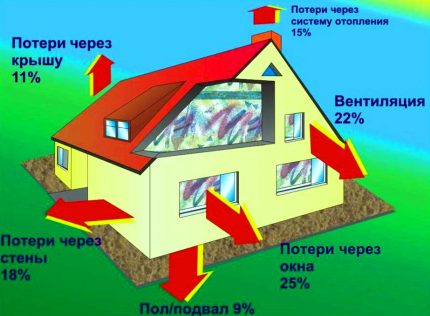
The second way to reduce gas consumption is to adjust the temperature using a thermostat. You can choose a mode in which the temperature decreases night and day, and in the morning and evening, when the family is assembled, it rises.
If you know how much a home gas convector consumes, you can calculate the monthly costs.
Criterion # 5 - instrument power
The comfort of those living in a heated room depends on the correct choice of power. On average, approximately 1 kW is required for a volume of 30 m³. For domestic use, devices from 2 kW to 12 kW are designed.
The market has a wide range of heating devices with a power of 2-6 kW with a steel heat exchanger. They are attractive for their design and low price, but their service life and efficiency are lower than that of counterparts with a cast-iron heat exchanger.
Given the likelihood of ventilation, drafts, insufficient insulation, you need to take the unit with a small margin of power. Suppose a 2 kW convector is required for a room of 40 m³.
Criterion # 6 - material for manufacturing work units
Heat exchangers and combustion chambers made of steel have two significant advantages: low weight and low cost.
It is estimated that devices with a steel chamber are approximately 12-15 kg lighter than analogues with cast-iron “fillings”. However, there is an important minus - even heat-resistant steel becomes unusable faster than cast iron, which means that a cheaper unit will be the first to be repaired. The best grades of metal serve up to 20 years.
The life of the cast-iron chamber is not limited, it does not rust and does not burn out, however, the metal is sensitive to sharp changes in temperature.
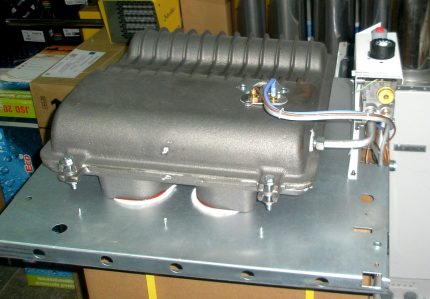
Cast iron is recognized as an ideal material for the manufacture of a heat exchanger. It heats up quickly, retains heat for a long time and evenly distributes it over the entire surface. The service life of such devices is up to 50 years. But there are also disadvantages - high weight and high price.
Criterion # 7 - natural or bottled gas
From an economic point of view, it is more profitable to connect convectors to natural gas, so all models are designed to run on main fuel. The installation diagram is simple, without additional components.
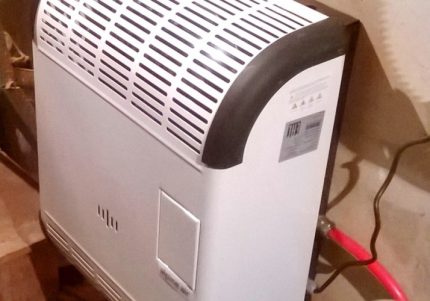
The disadvantages of using natural gas are considered to be dependence on fuel supply and control by the gas service, but these are mandatory components of the use of any equipment: stoves, columns, boilers.
Using a propane / butane mixture in gas bottles more expensive, but used everywhere where there is no possibility of connecting to the highway. Almost all models are adapted for conversion to work on natural gas - for this there is a special adapter in the delivery set.
We recommend connecting the cylinders in the presence of a gas service worker - it is better if a qualified specialist takes care of replacing the nozzles or reconfiguring the valve.
Popular manufacturers of gas convectors
The first places in the ratings of gas convectors are occupied by the models of two Turkish companies - Alpine Air and Hosseven. For heating dachas and cottages, they often purchase models for wall mounting, so there are a large selection of household wall-mounted series in the catalogs of both brands.
Models Hosseven with a cast-iron heat exchanger have proven themselves in heating private homes.Models 3 and 5 series were replaced by HP and HS-8 design devices with a glossy surface and heat-resistant glass on the front panel.
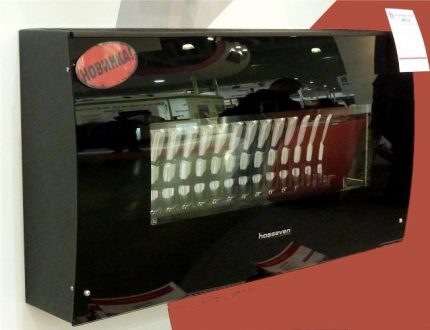
The basis for the production of heating appliances Alpine air steel convectors Demrad. Home appliances have the same specifications and design. The average power of domestic installations with a cast-iron heat exchanger of the NGS series is 2.5-5 kW.
Budget models of the DT series are equipped with a steel heat exchanger. The label F in the name indicates the presence of a fan.
Czech convectors Karma beta functional, reliable, easy to maintain, have earned popularity at a low price. Models of 4 series are delivered to Russia: Mechanic, Electronic, Comfort Mechanic, Comfort Electronic.
Mechanic devices are the best option for a summer residence. The lack of sophisticated electronics made them non-volatile. Ignition is carried out mechanically, from a piezoelectric element.
Ukrainian brand ATON Vektor produces safe, reliable and inexpensive heat engineering. Household models with a power of 2.2-5 kW have long been known in Russia, they are often used to connect to bottled gas.
In addition to the convectors of the listed brands, the Russian market includes devices of domestic brands Termotechnik, Vepr, Titan.
Conclusions and useful video on the topic
Visually about the design and functions of the devices:
Overview of gas heating technology:
To imagine how the installation occurs, the assembly instructions of the AKOG manufacturer:
Gas convectors are an alternative way of heating rooms. They are easy to install and maintain, and when connected to natural gas, they are economical.
Devices help out if you need to quickly warm the room or if the main heating system can not cope. Convection equipment can be used as a primary or backup heat source.
Want to share your own experiences in the selection and / or operation of gas-fired convective heaters? Do you have useful information on the topic of the article? Please write comments in the form below the block, ask questions, publish photos on the topic of the article.

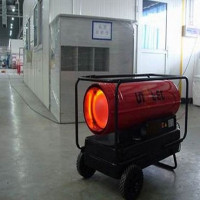 Thermal gas guns: device, selection options, an overview of popular manufacturers
Thermal gas guns: device, selection options, an overview of popular manufacturers 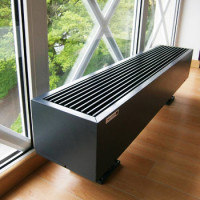 Water floor heating convectors: types, manufacturers, how to choose the best
Water floor heating convectors: types, manufacturers, how to choose the best 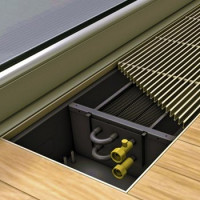 Water floor heating convectors: types, features of installation and arrangement
Water floor heating convectors: types, features of installation and arrangement 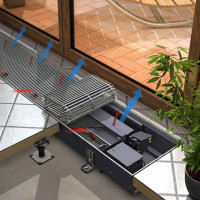 How to choose electric heating convectors: what to look at before buying + brand overview
How to choose electric heating convectors: what to look at before buying + brand overview 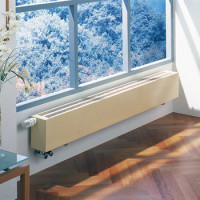 Water heating convectors: types, how to choose + an overview of popular models and brands
Water heating convectors: types, how to choose + an overview of popular models and brands 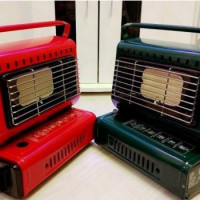 Catalytic gas heater: varieties, recommendations for selection + review of the best brands
Catalytic gas heater: varieties, recommendations for selection + review of the best brands  How much does it cost to connect gas to a private house: the price of organizing gas supply
How much does it cost to connect gas to a private house: the price of organizing gas supply  The best washing machines with dryer: model rating and customer tips
The best washing machines with dryer: model rating and customer tips  What is the color temperature of light and the nuances of choosing the temperature of the lamps to suit your needs
What is the color temperature of light and the nuances of choosing the temperature of the lamps to suit your needs  Replacement of a geyser in an apartment: replacement paperwork + basic norms and requirements
Replacement of a geyser in an apartment: replacement paperwork + basic norms and requirements